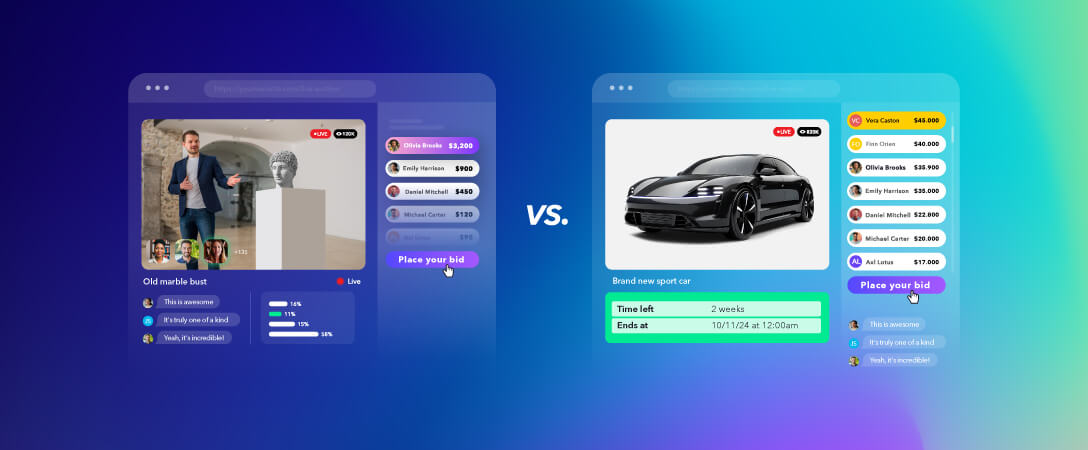Auctions are a widespread and longstanding method for buying and selling a wide range of items, from rare antiques to modern technology. In today’s digital age, the auction world has expanded online, introducing new formats and making bidding accessible to people worldwide.
Two of the most prominent types of online auctions are live auctions and timed auctions. While both aim to create a competitive environment that drives sales or fundraising, they differ significantly in their experience and operational approach.
In this article, we will compare two popular types of online auctions. We will break down the differences between live auctions and timed auctions before comparing them side by side.
An overview of live auctions vs. timed auctions
A live auction, when conducted online, replicates the excitement of a traditional auction house, with an auctioneer directing the bidding in real-time. A timed auction, on the other hand, takes place over a specific period, accepting bids until a predetermined deadline and without an auctioneer overseeing the process.
Understanding the benefits and challenges of both is essential for anyone hoping to sell or buy through an auction format, as the online auction market is forecasted to grow at a CAGR of 14% from 2024 to 2029, reaching a value of $3.98 billion.
What is a live auction?
A live auction is a real-time event where an auctioneer oversees the bidding process. Usually a professional, this individual’s job is to generate energy in a crowd and motivate them to place higher and higher bids. Participants can join either in person or via an online platform where they can watch the proceedings and place bets in real-time.
Live auctions are famously dynamic and fast-paced, creating an atmosphere of urgency and excitement. The auctioneer plays a crucial role in managing the event’s overall flow and encouraging a sense of competition.
How live online auctions work
Live auctions rely heavily on technology to create a seamless and engaging experience for all participants, whether they are present in person or online. Let’s explore the core components of a live auction.
An auctioneer
An auctioneer moderates the event, bidding, and determining winners. This person also sets the pace for live auction timing and encourages less engaged attendees to participate. With an auctioneer, online auctions feel more lifelike.
Real-time streaming
Real-time streaming technology is crucial in live auctions to ensure that remote participants have a seamless experience, just as in-person attendees do. Even if the event is entirely online, the slightest lag can throw off bidding or undermine a bet’s legitimacy.
Streaming solutions, such as Dolby OptiView, often feature live auction streaming software, audio feeds, and other functionalities that provide a seamless experience.
Auction software
Auction software is another essential for hosting live auctions. This sort of tool provides a virtual environment where remote bidders can participate. Your chosen auction software should integrate seamlessly with your real-time streaming solution.
Bid tracking software
Because live auctions are fast-paced, it can be difficult for laborers to monitor everything that happens, so a system that tracks bids in real-time and updates the current highest bids is always beneficial.
These systems can also notify participants of new bids and must be highly responsive to prevent delays or errors.

Live auction use cases
Live auctions are particularly effective in scenarios where organizers need to invoke a sense of urgency and competition. Here are some common live auction use cases.
Luxury goods and art
High-value items such as fine art, antiques, and jewelry are often sold through live auctions to maximize buyer competition and drive up the final sale price. These items are especially suited for auctions because it’s difficult to assign an individual retail price. Since their value is subjective, their final cost is determined by how much they are worth to individual bidders.
Charity events
Charities and nonprofits also favor live auctions as a fundraising tool because they create excitement and encourage higher donations. The majority of the items or services sold are donated, allowing organizations to raise more money when participants bid higher than the item is typically valued at.
Real estate
Properties can be auctioned in a live setting to attract serious buyers and quickly close sales. This is especially popular among banks that are selling foreclosures and properties with similar circumstances.
Collectibles and memorabilia
Rare or unique items, such as sports memorabilia or vintage collectibles, are similar to luxury goods in that their value depends on individual bidders and are thus ideal for live auction settings.
Live auction benefits and challenges
Live auctions are a great way to raise funds and drive sales, but they’re not without their obstacles. Let’s weigh the pros and cons.
Benefits
- Sense of urgency: The fast-paced nature of live auctions encourages quick decision-making and active participation. This urgency leverages people’s fear of missing out — they don’t want that last exciting item to go to someone else!
- Competitive environment: Real-time bidding can drive up prices, resulting in higher returns for sellers.
- Buyer and seller commitment: Live auctions often involve serious buyers who are committed to purchasing, reducing the risk of sales falling through.
- Immediate results: Bidders and sellers receive immediate feedback on the auction outcome.
Challenges
- Scalability: Managing a large number of participants and ensuring a smooth experience can be difficult. Robust live auction software offers scalability and reliability, featuring high-quality audio and real-time video streaming, allowing you to host auctions with a large number of attendees without worrying about system overload.
- Manual bidding: Unlike timed auctions, live auctions typically require active, real-time participation, which can be demanding for both buyers and sellers.
- Higher production costs: Live auction events can be more expensive than their timed auction counterparts because they require professional auctioneers, faster streaming technology, and bid-tracking systems.
What is a timed auction?
A timed auction is an auction format in which items are available for bidding over a specified period, typically several days or weeks. There is no live auctioneer, and participants can place bids at any time before the auction closes. The highest bid at the end of the designated period wins the item.
Timed online auctions are more flexible than live auctions, as they allow participants to bid at their convenience. This format is commonly used on digital platforms where organizers list large numbers of items simultaneously. Silent auctions are a form of timed auction, which are also common at charity events and sometimes accompany a live version.
How timed online auctions work
Functionality and technology
Organizers rely on technology to handle bids and automate timed auctions, including notifying participants and determining winners. Here are a few core components of a timed auction.
Auction software
Auction software is also valuable for timed auctions. These platforms are also often present at in-person timed auctions to streamline the process. Participants can access this technology on their mobile devices or nearby screens.
Automated bidding system
Just like with live auctions, you’ll need an automated bidding system that automatically accepts bids and updates participants on the current highest bid. This allows attendees to focus on other tasks while continuing to place bets in the background.
Notification system
A notification system is another essential part of your timed auction work tech stack. This sort of tool alerts bidders when they are outbid or when the auction is nearing its end, encouraging further bidding.

Timed auction use cases
Timed auctions are ideal in scenarios where flexibility and scalability are more important than real-time engagement. Here are a few of the top use cases.
eCommerce platforms
Websites like eBay frequently utilize timed auctions to sell a diverse range of products, enabling sellers to reach a global and more diverse audience. Retailers can add leverage auctioning to drive sales on their online storefronts, as well.
Surplus and liquidation sales
Companies looking to sell excess inventory or liquidate assets quickly often utilize timed online auctions to maximize the sale of as many items as possible. Government organizations can also leverage timed auctions to sell surplus property, vehicles, and other assets.
Charity events
Nonprofits can utilize both timed auctions and live auctions. Although time auctions lack the spirit of competition that drives up bids, auctioning donated items is a convenient way to raise funds.
Benefits and challenges of streaming timed auctions
Timed auctions come with several benefits and challenges. Here’s what you should consider.
Benefits of streaming timed auctions
- Global scalability: Timed auctions can attract participants from around the world, thereby increasing the pool of potential buyers.
- Self-paced bidding: Participants can bid at their convenience without the pressure of real-time competition and browse an auction’s catalog for a more extended period.
- Automated systems: Timed auctions reduce the need for manual oversight, making them easier to manage and less costly to run.
Challenges of streaming timed auctions
- Market saturation: Individual items may receive less attention when numerous items are listed simultaneously.
- Lack of commitment: Unlike live auctions, buyers and sellers may back out of a sale since there is no real-time engagement or urgency.
- Lack of urgency: The format’s extended duration may reduce the sense of immediacy, potentially leading to lower final bid amounts.
Timed auctions vs. live auctions: what’s the difference?
Now that you’re familiar with both live and timed auctions, let’s take a look at how these different types of online auctions compare side by side.
Engagement and interactivity
Live auctions provide real-time engagement and interactivity, generating excitement and motivating individuals to make purchases. Timed auctions do not offer this level of engagement.
Technology requirements
Live auctions require robust streaming and real-time bid-tracking technologies, whereas timed auctions rely more on automation and notification systems. That said, timed auctions still benefit from high-resolution video content to showcase items and encourage bidding.
Scalability
Timed auctions are more scalable due to their automated nature, whereas live auctions require more resources to handle large numbers of participants.
Which type of online auction is right for you?
With an understanding of how the different types of online auctions compare, it’s time to decide which is best for your use case. The choice you make depends on your specific needs and goals.
Live auctions are ideal if you’re trying to sell more items or raise more money in a shorter timeframe, or sell high-value goods. Timed auctions are suitable for selling large volumes of items, reaching a broader audience, or allowing bidders to participate at their convenience.
Final thoughts
Both live and timed auctions present great opportunities for making sales online as long as you have the support of the right technology. As you compare the two types of online auctions, keep your organization’s unique needs in mind.
Looking for a reliable streaming solution to support your live auctions? Dolby OptiView provides the tools you need to deliver a high-quality, trustworthy experience. Contact us to discover how our real-time streaming solution can enhance the seamless experience of your events.








